The AMD A10-7700K and AMD A6-7400K CPU Mini-Review
by Ian Cutress on May 27, 2015 9:00 AM ESTOffice Performance
The dynamics of CPU Turbo modes, both Intel and AMD, can cause concern during environments with a variable threaded workload. There is also an added issue of the motherboard remaining consistent, depending on how the motherboard manufacturer wants to add in their own boosting technologies over the ones that Intel would prefer they used. In order to remain consistent, we implement an OS-level unique high performance mode on all the CPUs we test which should override any motherboard manufacturer performance mode.
All of our benchmark results can also be found in our benchmark engine, Bench.
Dolphin Benchmark: link
Many emulators are often bound by single thread CPU performance, and general reports tended to suggest that Haswell provided a significant boost to emulator performance. This benchmark runs a Wii program that raytraces a complex 3D scene inside the Dolphin Wii emulator. Performance on this benchmark is a good proxy of the speed of Dolphin CPU emulation, which is an intensive single core task using most aspects of a CPU. Results are given in minutes, where the Wii itself scores 17.53 minutes.
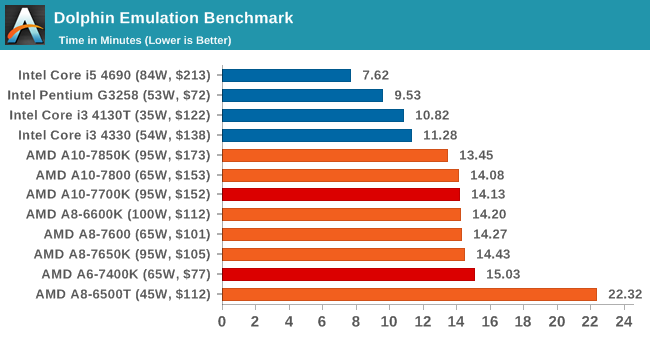
WinRAR 5.0.1: link
Our WinRAR test from 2013 is updated to the latest version of WinRAR at the start of 2014. We compress a set of 2867 files across 320 folders totaling 1.52 GB in size – 95% of these files are small typical website files, and the rest (90% of the size) are small 30 second 720p videos.
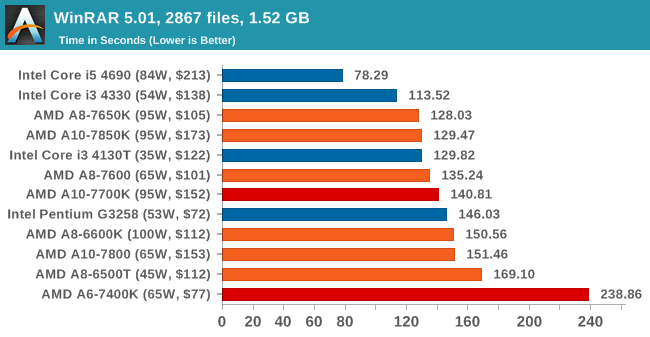
The single module of the 7400K shows the deficit in a slightly threaded workload.
Image Manipulation – FastStone Image Viewer 4.9: link
Similarly to WinRAR, the FastStone test us updated to the latest version. FastStone is the program I use to perform quick or bulk actions on images, such as resizing, adjusting for color and cropping. In our test we take a series of 170 images in various sizes and formats and convert them all into 640x480 .gif files, maintaining the aspect ratio. FastStone does not use multithreading for this test, and thus single threaded performance is often the winner.
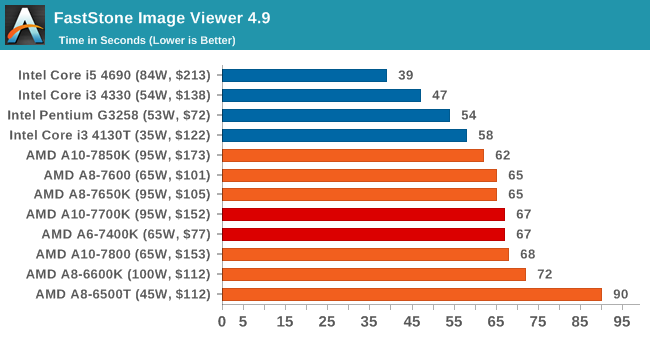
For a purely single threaded test, both of the AMD APUs performed similarly here.
Web Benchmarks
On the lower end processors, general usability is a big factor of experience, especially as we move into the HTML5 era of web browsing. For our web benchmarks, we take well known tests with Chrome 35 as a consistent browser.
Mozilla Kraken 1.1
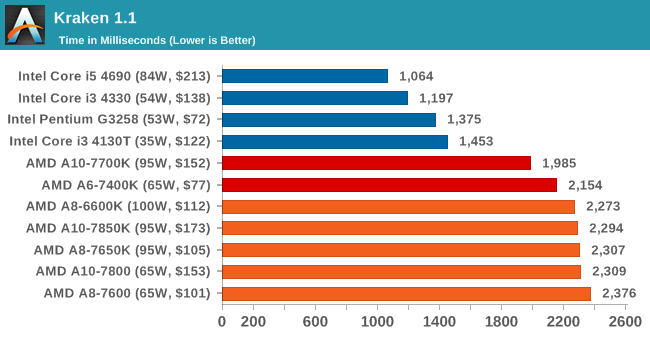
Google Octane v2

Professional Performance: Windows
We have a few benchmarks to characterise professional level performance on Windows.
Agisoft Photoscan – 2D to 3D Image Manipulation: link
Agisoft Photoscan creates 3D models from 2D images, a process which is very computationally expensive. The algorithm is split into four distinct phases, and different phases of the model reconstruction require either fast memory, fast IPC, more cores, or even OpenCL compute devices to hand. Agisoft supplied us with a special version of the software to script the process, where we take 50 images of a stately home and convert it into a medium quality model. This benchmark typically takes around 15-20 minutes on a high end PC on the CPU alone, with GPUs reducing the time.
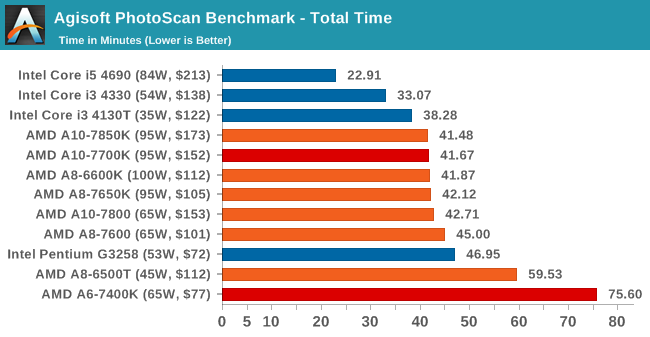
Cinebench R15
Cinebench is a benchmark based around Cinema 4D, and is fairly well known among enthusiasts for stressing the CPU for a provided workload. Results are given as a score, where higher is better.
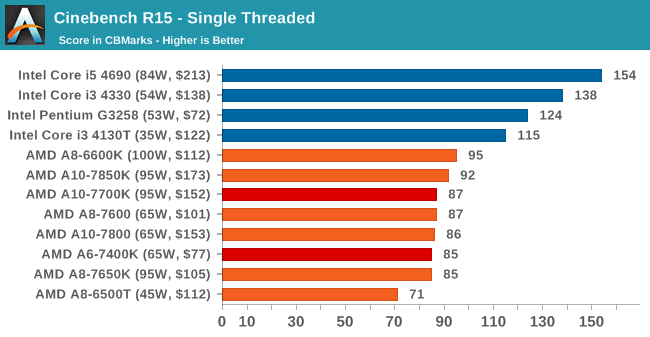

Linux Performance
Built around several freely available benchmarks for Linux, Linux-Bench is a project spearheaded by Patrick at ServeTheHome to streamline about a dozen of these tests in a single neat package run via a set of three commands using an Ubuntu 11.04 LiveCD. These tests include fluid dynamics used by NASA, ray-tracing, OpenSSL, molecular modeling, and a scalable data structure server for web deployments. We run Linux-Bench and have chosen to report a select few of the tests that rely on CPU and DRAM speed.
C-Ray: link
C-Ray is a simple ray-tracing program that focuses almost exclusively on processor performance rather than DRAM access. The test in Linux-Bench renders a heavy complex scene offering a large scalable scenario.
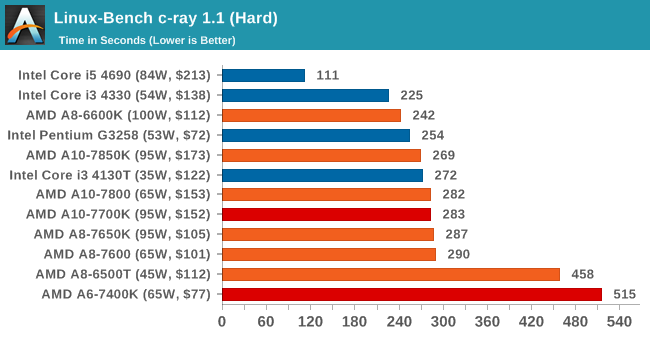
NAMD, Scalable Molecular Dynamics: link
Developed by the Theoretical and Computational Biophysics Group at the University of Illinois at Urbana-Champaign, NAMD is a set of parallel molecular dynamics codes for extreme parallelization up to and beyond 200,000 cores. The reference paper detailing NAMD has over 4000 citations, and our testing runs a small simulation where the calculation steps per unit time is the output vector.
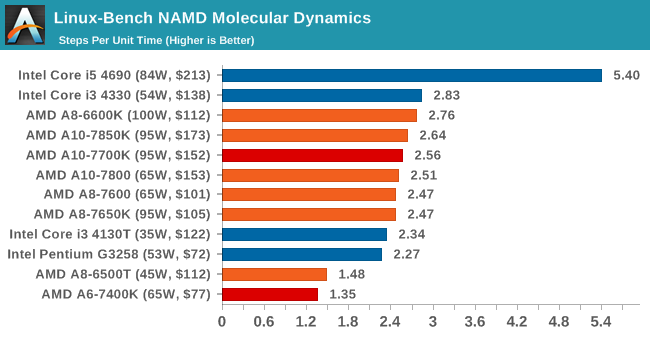
NPB, Fluid Dynamics: link
Aside from LINPACK, there are many other ways to benchmark supercomputers in terms of how effective they are for various types of mathematical processes. The NAS Parallel Benchmarks (NPB) are a set of small programs originally designed for NASA to test their supercomputers in terms of fluid dynamics simulations, useful for airflow reactions and design.











105 Comments
View All Comments
eRacer1 - Thursday, May 28, 2015 - link
"For those of us not red/green colorblind a review of the 7870k and 870k with their larger stock cpu coolers and improved IPC would have been very welcome."First review at CPU-World: http://www.cpu-world.com/news_2015/2015052601_AMD_...
"Both APUs have Radeon R7 graphics with 512 shaders, and the only difference is much higher GPU clock of the 7870K model. It runs at 867 MHz, which means that it could be up to 20% faster than the A10-7850K. Alas, we could not verify this assumption as the processor was not stable with the latest Catalyst beta drivers. It also did not run well enough in pure CPU applications, throttling down to the lowest power state after about 20 seconds of heavy load, then going back to one of the turbo power states, then throttling back, and so on...
This unexpected behavior prevented us from running any benchmarks as their results all turned out to be much lower than expected."
Looks like AMD sent out a PR statement about the launch. Did AMD marketing "forget" to send out samples for review?
Crunchy005 - Wednesday, May 27, 2015 - link
Ya one of the biggest differences between AMD, nvidia, and intel is AMD sucks at marketing. I mean look at Apple they aren't always the best for the price but they market really well and people don't notice, although you always get a quality computer even if you can get a more powerful windows for the same price.nils_ - Wednesday, May 27, 2015 - link
I have heard of the i5/i7 with only 2 cores (current Broadwell for example), but never heard of an i7 without HT?extide - Wednesday, May 27, 2015 - link
Those are mobile processors, and follow different rules. On the desktop, i7 means >= 4 cores + HT, while in the mobile line i7 means 4MB L3 cache / 2 cores. Mobile i3/i5/i7 all have HT.Desktop:
i3 - 2 cores, 2-3MB L3 x100 series = 2MB, x300 series = 3MB. No HT, No Turbo.
i5 - 4 cores, 6MB L3 Except R series, which has 4MB), No HT, Yes Turbo.
i7 - 4cores, 8MB L3 (Except R series, which has 6MB) Yes HT, Yes Turbo. (NOT INCLUDING HEDT PARTS)
Mobile:
i3 - Dual Core 3MB L3, Yes HT, No Turbo
i5 - Dual Core 3MB L3, Yes HT, Yes Turbo.
i7 - Dual Core 4MB L3 / Quad Core 6-8MB L3, Yes HT, Yes Turbo.
artk2219 - Wednesday, May 27, 2015 - link
Ah, but even on the desktop an I5 designation does not automatically mean that it has 4 cores, Intel still launches 2 core 4 thread "I5's", and they have since the launch of the original I5 (See the I5 680, 2390T, 3470T, 4570T, and 4570TE). Don't get me wrong, I absolutely hate the fact that they called this chip an "A10", but they're both guilty of this crap. Dont even get me started on most of the mobile "I7's".http://www.cpu-world.com/CPUs/Core_i5/TYPE-Core%20...
artk2219 - Wednesday, May 27, 2015 - link
Another note is that all I3's have HT, but not turbo. This is essentially what differentiates a mobile I5 from a mobile I3. Another note is that the pentium's are just I3's with no hyperthreading, and the Celeron is a lower clocked, lower cached, Pentium.extide - Monday, June 1, 2015 - link
Yeah, those T series don;t always follow the mold, but for the most part, there is indeed a logical way they do things.Although, they could have done better, for sure.
MrSpadge - Wednesday, May 27, 2015 - link
I agree, their Ax designations are moslty useless at best, or even misleading at worst.However, to be fair: Kaveri with 512 SPs or 384 SPs does not matter much in the real world. The bigger config is bandwidth starved anyway. This is not meant to be an excuse, just some soothing balm for "Essence_of_War" and other users.
Myrandex - Wednesday, May 27, 2015 - link
Oh what do you know my i5 I'm typing this on right now is dual core four threads. Yea AMD sucks for doing this, this CPU is the same as the highest end A8 with just 100MHz. increase on the base non turbo clock, what a waste. Intel is not guilt free either though they do crap like this as well especially in their mobile line.leexgx - Thursday, May 28, 2015 - link
almost all Mobile CPUs i5 are dual core cpus,but i agree i3 should be dual core with HT, i5 should be Quad core no HT and i7 should be Quad core with HT, but even so the i3 is faster then A10 typically